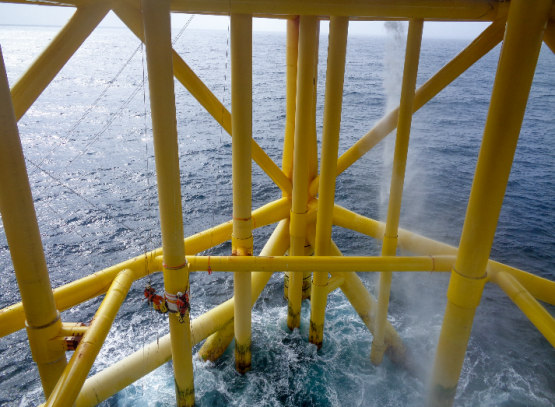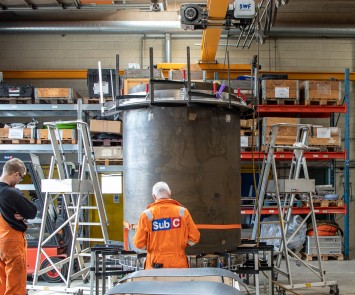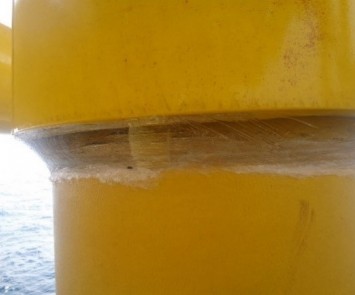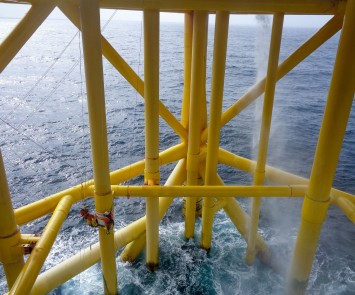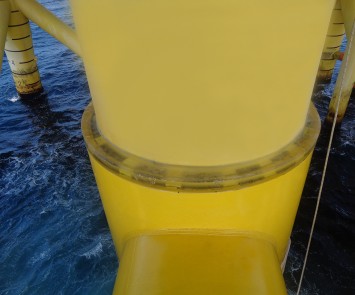Fatigue Reducing Liner
The challenge
After installation of the three Total UK operated Culzean platforms, excessive relative movements were observed on several caissons within their support guides. Such movements could potentially lead to fatigue-related hazards.
Traditionally such movements are avoided by inserting wood or plastic wedges between the caisson pipe and the support guide. As the wedges are slowly, but surely, being either worn down or forced out from the same micromovement that induces the fatigue they try to prevent, both within a relatively short time.
Total UK was looking for a solution, that would be permanent, ensuring a long lifetime for the caissons while reducing the need for continuously inserting new wedges and inspection for missing wedges.
This would benefit to reduce the manhours allocated and the overall maintenance costs.
The requirements for the job
- 16 caissons to be secured by this solution
- Development of a product for injection
- Temperature not to exceed 100° C, to keep the coating integrity during curing
- The final hardness of the product must be around 50 Shore D
- Duration of curing from casting to completion is max. 5 days
- The final product must be suitable for temperature between -10 to +80° C.
- The final product must be suitable for the environment (UV resistant, SW resistant etc.)
- The final product should be able to withstand app. 7 million expansion cycles/year for 40 years (280 million cycles)
- Use of wedges during installation
- Cope with the present inside neoprene liner
- Installation friendly
The solution
SubC Partner was contacted by Total UK to engineer a solution. The experience from SubC pointed towards a grouted solution, however, due to the movements, the solution needed a material that would support both push and pull forces while remaining extremely stable.
First SubC looked into a traditional grouted solution, however, due to the cycle requirements, this material type was discarded. The choice of material fell on epoxy resin. Initial tests of the standard epoxy compound showed the need for a redesign of the chemical composition. SubC, therefore, designed and tested special epoxy compounds optimizing for the ideal composition fulfilling the requirements.
The selected compound has the unique properties of being both strong and ductile at the same time, thus securing the properties for many years of thermal and fatigue-induced impacts offshore.
Testing is standard routine prior to mobilization ensuring full product compliance, and the safety for people involved and protection of the environment. Having completed the product design followed by throughout testing, the solution was approved by Total UK as a universal product to solve the Culzean fatigue movement issues.
After the go-ahead with the liner product training of the SubC rope access technicians was conducted to make sure that the chemical process during installation was done safely and correctly, as the work location is situated 5-16 meters above sea level, to ensure high job performance.
As part of our vertical integrated business model, we hold all competences and experience in-house, which allows us to do rapid iterations on developing a solution like this.
Seals
Due to different guide designs, special sealing types were designed for each. The work included the development of custom-made environmentally isolating installation seals, development of epoxy mixture, injection techniques, equipment, offshore operation etc.
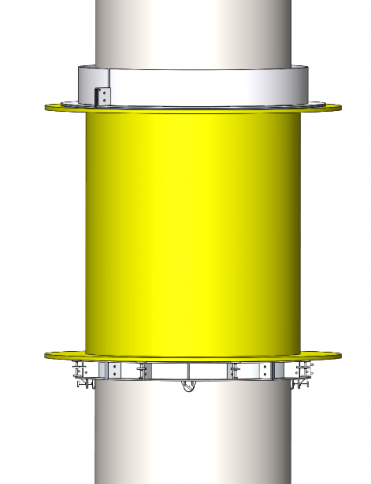
Installation
For the installation, a detailed methods statement was produced and approved by Total UK fulfilling all requirements, as above-mentioned. Due to the large volume +200 litre, the ‘plug’ fill method was selected. After curing the first fill acts as an additional load barrier and seal before injecting the remaining 75-85% of the epoxy. Therefore, known as “the plug”.
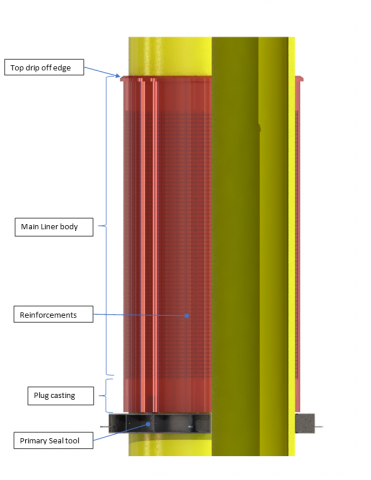
Hang-off facility and reinforcement
To enhance the hang-off facility at the guide top a “top-hat” design was developed adding an additional 75mm high volume of resin, above the upper guide edge. In addition, stainless reinforcement net was suggested and introduced. Both ensures strong and long-lasting capabilities.
Fatigue Reducing Liner, Technical overview
The liner is built to withstand oscillations in both forces and thermal expansions. The main material is a specially developed epoxy compound that handles both tension and compression very well. To safeguard the very large volume and secure the curing process, then, a stainless-steel reinforcement structure is inserted in the void space prior to casting. The reinforcement structure is aligned using the same clamping tools that act as the primary sealing bodies during the casting process.
A secondary seal is accomplished by wrapping the entire casting tool in a temporary heat resistant flexible polymer sheet. The third spill is securing the attachment of a mechanical spill tray below the primary and secondary seals.
During casting the first 5% is casted and cured before the main body is casted. Then the first casting acts as a seal for the majority of the epoxy and the need for spill protection is only relevant for the first section.
Innovative component
The main innovative component is the holistic approach to a specific problem. As it is customary, the movement is stopped by wedges, knowingly that the wedges are a temporary solution. By stepping back and looking at the entire suspension environment, we were able to identify key components that were needed to make the refit a permanent and controlled long term solution.
Safety advantages
The solution effectively reduces, and in most cases eliminates, the need for yearly rope access inspections below cellar deck on the caissons. This reduces personnel exposure to the elements and thereby increase safety. Structural safety is also increased as the solution is permanent, and the fatigue element from the sea induced movement is predictable. Using wedges, it is difficult to say for how long the movement has been critical in case of missing wedges. Fatigue calculations may then be estimated conservatively and reduce the remaining fatigue life.
Cost advantages
The cost advantage follows the safety advantage directly. Less working hours on the installation in relation to the caissons reduces overall cost and fewer beds occupied by this staff free up the platform for other potentially value increasing jobs. Also, fewer logistics and planning related to yearly inspections.
Alternative use of method
The solution can be adopted for conductors as well, which is known to have similar problems.
This project was completed in 2019
